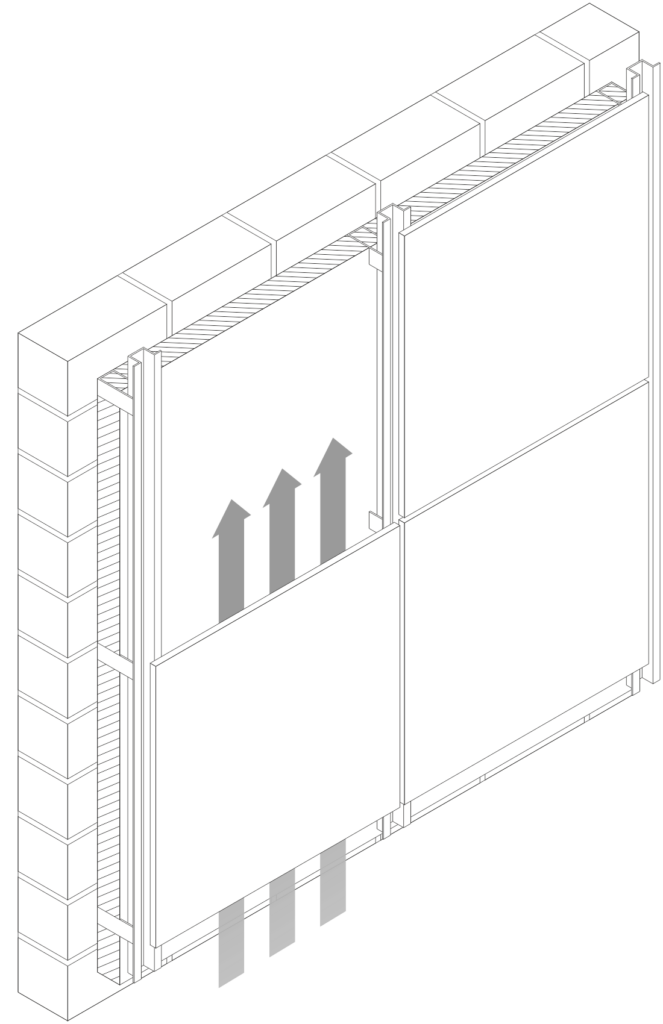In the search for cladding and insulation solutions for buildings, the ventilated façade and the External Thermal Insulation System (ETICS) are presented as outstanding alternatives. This article aims to elucidate the characteristics, advantages and considerations of both systems to facilitate an informed choice.
Structure and Functioning
Ventilated façade:
This system includes an air chamber that allows circulation, providing superior ventilation and thermal insulation, as well as great stability in terms of thermal gains.
In addition to the aluminium composite panel, this system allows the use of a multitude of materials such as stone, fibrocement, phenolics, ceramics, etc., which totally transform the appearance of a façade.

ETICS system:
Unlike the ventilated façade, the ETICS adheres a thermal insulation to the wall, followed by a special mortar, without including the characteristic air chamber or the option of incorporating other materials for exterior finishes.

Advantages and Disadvantages
The ventilated façade is distinguished by its thermal regulation and protection against humidity, while ETICS is recognised for its effectiveness in direct thermal insulation.
Cost and variation factors
The price of a ventilated façade can be higher, especially due to the inclusion of some more expensive materials such as stone, and the greater technical complexity of its installation. However, this initial difference is amortised in the first few years after the project is implemented.
Energy savings and standards
Both systems must comply with current regulations, which require energy efficiency and compliance with safety and quality standards. Both in the composition of the insulating materials and in the exterior materials in the case of the ventilated façade, it is important that they meet the requirements of reaction to fire.
Durability and maintenance
Both the ventilated façade and the ETICS, if properly maintained, promise a long useful life, with differentiated maintenance given their constructive nature. However, as we will see later, ETICS can have a lower performance and useful life in less stable climates, with high thermal gains or high humidity.
Appearance and thermal-acoustic insulation
The ventilated façade offers a wider aesthetic variety, thanks to the use of aluminium composite panels and other materials, as well as superior thermal and acoustic insulation due to its design.
Grants and subsidies
The authorities offer subsidies for projects that improve energy efficiency, applicable to both systems in different contexts. In Spain and Portugal, thanks to the European Next Generation funds, interesting subsidies of up to 40% of the value of the work are currently available for energy efficiency improvement projects.
Performance in humid and rainy climates
The effectiveness of the ventilated façade and ETICS can vary significantly in areas with high humidity and rainfall, such as in certain regions of Spain and Portugal.
Ventilated façade:
The air chamber in the ventilated façade facilitates the evaporation of moisture and reduces the possibility of leaks, which is particularly advantageous in rainy and humid climates.
ETICS system:
Although ETICS provides good insulation against thermal losses, in areas of high rainfall it may require additional waterproofing to avoid moisture and leakage problems in the façade.
Comparative analysis of rehabilitation costs
In general terms, the initial cost of a façade renovation may be higher if we choose the ventilated façade system over ETICS, although this difference is amortised in a short period of time, as we will see below.
For a single-family house of 120 m², the installation of a ventilated façade in aluminium composite panel could represent an extra cost of between 20% and 25% compared to an ETICS system, due to the greater technical complexity of its installation and the greater number of components involved in the system.
In larger projects, such as a 6-storey residential building, the relative cost overrun may decrease due to economies of scale, and the ventilated façade could represent a cost overrun of 12% to 20% compared to ETICS.
Thanks to its higher energy efficiency and better performance and durability in adverse climates, a ventilated façade can provide cost savings compared to a similar ETICS façade and amortise the initial cost difference within the first 10 years, resulting in significant savings over its lifetime.
The above costs are estimates based on practical cases of the most frequent characteristics, and depend on multiple factors such as the complexity of the design, the choice of materials and the working conditions at the project location.
Frequently asked questions
Does the ETICS system allow multiple exterior finishes?
Due to the nature of its application system, ETICS is more limited than the ventilated façade in terms of the variety of materials and finishes.
Which system is best suited for areas with high humidity?
The ventilated façade is often more suitable in humid and rainy areas due to its ability to handle moisture and prevent leaks.
How does the climate in my region influence the choice between ventilated façade and ETICS?
Climate is a determining factor; a ventilated façade is recommended in humid areas, while ETICS is usually enough in areas with more stable climates.
Conclusion
The choice between implementing a ventilated façade or an ETICS system should not be based solely on the initial cost. It is essential to consider long-term energy efficiency, durability, maintenance and site-specific climatic conditions.
A detailed assessment, including relative cost overruns and long-term benefits, will help to make the right decision for each particular situation. Consulting with professionals is crucial to optimise the energy efficiency and durability of the chosen system.

